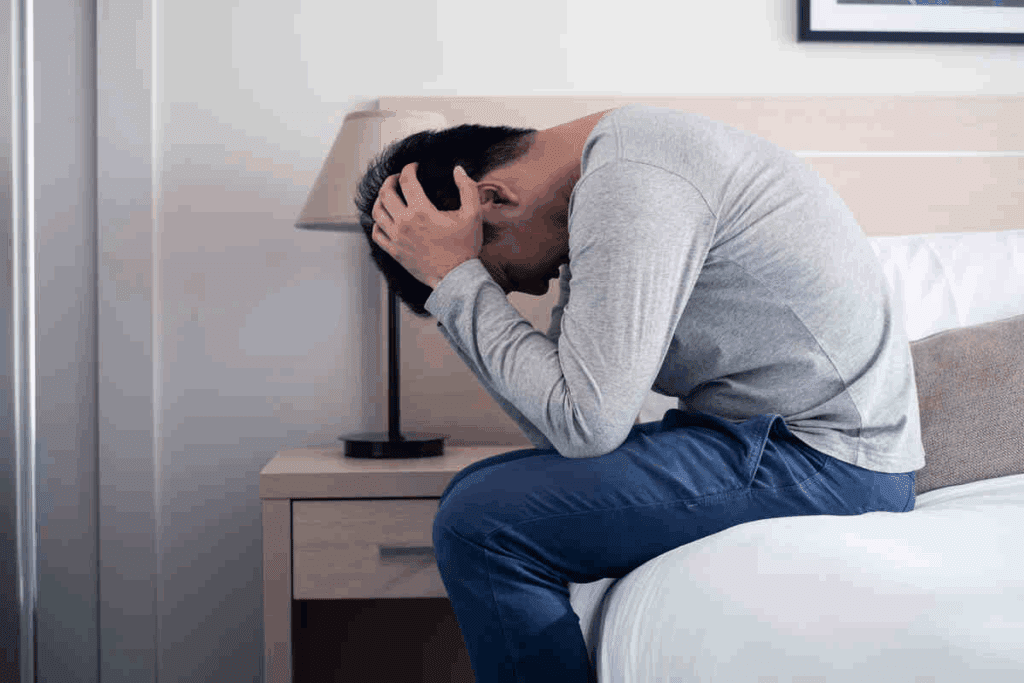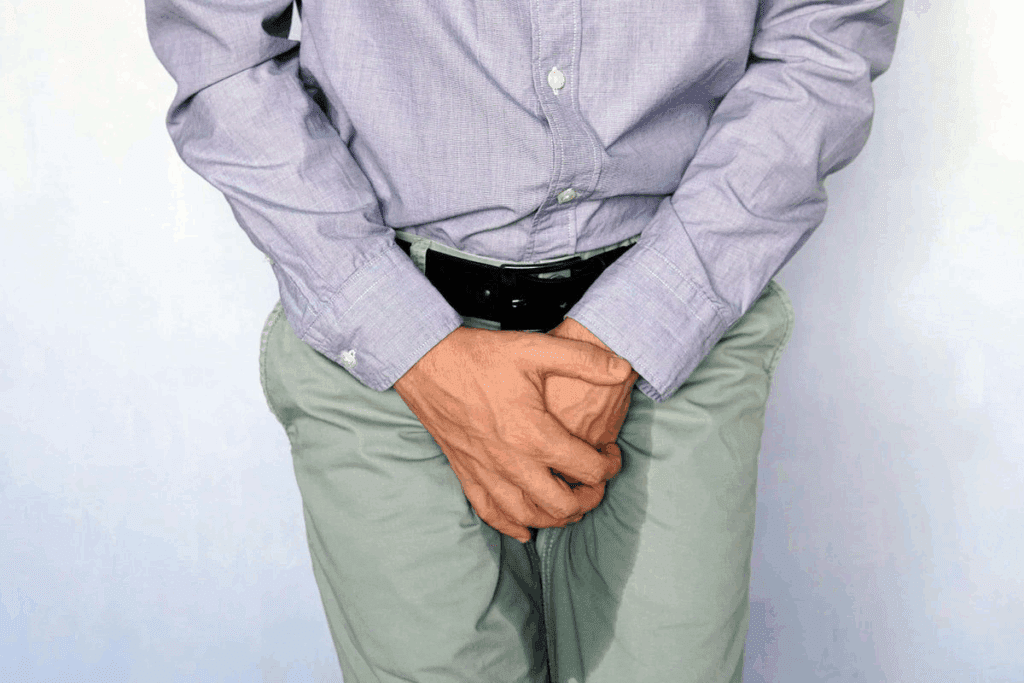
Urinary incontinence is a big health issue that affects millions of men around the world. It causes embarrassment and discomfort. It’s not just about leaking; it’s a complex issue. It’s influenced by medical conditions, surgeries, and age-related changes.Learn the 7 main reasons for male incontinence, including prostate issues and nerve damage, along with effective solutions for each.
Understanding the underlying causes of male incontinence is key for effective management and treatment. At Liv Hospital, we use international standards and patient-centered care. We identify the root cause of your incontinence and offer custom solutions. About 3% to 11% of men are affected, and this number goes up to 21% to 32% in elderly men.
We know that male urinary incontinence is a treatable condition. Getting specialized care can help restore confidence and improve your quality of life.

Urinary incontinence in men is a big health issue. It needs attention and proper management to improve life quality. It’s not just a small problem; it affects daily life, social interactions, and overall well-being.
Many men face urinary incontinence, more than people think. It’s common, mainly in older men. The risk grows with age, linked to benign prostatic hyperplasia (BPH), prostate cancer, and neurological issues.
The effects on a man’s life can be huge. It can cause social isolation and make men shy away from social events. It also harms mental health, causing anxiety and depression.
Many men hide their incontinence, thinking it’s just aging. But, it’s not normal to leak urine. There are treatments to manage or cure it.
Getting medical help is key to controlling the bladder and improving life. Doctors can find the cause and suggest treatments. These might include lifestyle changes, pelvic floor exercises, or medical devices.
Understanding incontinence and its causes is the first step to seeking help. It’s vital to tackle this condition with empathy and a drive to find solutions.

It’s important to know the different types of male incontinence to manage and treat it well. Male incontinence covers many urinary control issues, not just one.
Stress incontinence happens when moving or pressure on the bladder causes urine to leak out. This can be due to prostate surgery or injuries that affect the urinary sphincter.
Urge incontinence is when you suddenly feel a strong need to pee, and then you can’t hold it. It’s often linked to an overactive bladder that contracts too much.
Overflow incontinence is when the bladder doesn’t empty fully, causing urine to leak out constantly. This can lead to serious problems like infections, bladder damage, and even kidney failure if not treated.
Mixed incontinence is when you have both stress and urge incontinence. Functional incontinence is when you can’t get to the bathroom because of physical or mental issues, even if you have normal bladder control.
Knowing the exact type of incontinence is key to finding the right treatment. We’ll look at different ways to manage and treat it in the next sections.
Male urinary incontinence has many causes. Knowing these is key to finding ways to stop it or treat it.
Several things can lead to male incontinence. These include BPH, prostate cancer surgery issues, diabetes, Parkinson’s disease, urinary tract infections, and muscle weakness with age. Each one affects incontinence differently.
BPH can block urine flow, causing overflow incontinence. Prostate cancer surgery can harm the muscles and nerves that control urination, leading to stress incontinence.
Some things make a man more likely to have incontinence. These are age, certain health issues like diabetes and Parkinson’s, and past prostate surgery. Knowing these risks helps prevent incontinence.
To prevent it, manage health issues, stay at a healthy weight, and do pelvic floor exercises. Talking to a doctor about prevention can also help a lot.
| Risk Factor | Description | Prevention Strategy |
| Age | Incontinence risk increases with age | Regular pelvic floor exercises |
| Diabetes | Neurological damage can affect bladder control | Manage blood sugar levels |
| Prostate Surgery | Surgery can damage urinary sphincter muscles | Pelvic floor rehabilitation |
By knowing the causes and risks of male incontinence, men can act early. This can greatly improve their life quality.
Benign Prostatic Hyperplasia, or BPH, is a common issue for older men. It affects how they urinate. As men get older, their prostate gland grows, which can block the urethra and make it hard to pee.
BPH can cause many urinary problems because of the blockage. This blockage makes the bladder work harder. It can lead to an overactive bladder and incontinence.
A study in the Journal of Urology found that BPH greatly affects older men’s quality of life.
“The pathophysiology of BPH involves both static and dynamic components, with the static component related to the enlargement of the prostate and the dynamic component related to the tone of the prostatic smooth muscle.”
Common symptoms of BPH include:
Spotting these symptoms early can help get the right medical care. This can lower the risk of serious problems.
Treatment for BPH depends on how bad the symptoms are. It may include:
| Treatment Type | Description |
| Watchful Waiting | Monitoring symptoms without immediate treatment |
| Medications | Alpha-blockers and 5-alpha-reductase inhibitors to relax prostate muscles and shrink the prostate |
| Surgical Options | Procedures like Transurethral Resection of the Prostate (TURP) or laser surgery to remove or reduce the prostate size |
Knowing about the different treatments is key to managing BPH well. It helps improve a man’s quality of life.
Prostate cancer treatments, like surgery and radiation, can affect bladder control. Men going through these treatments might find it hard to control their bladder. This can make their life quality worse.
Post-prostatectomy incontinence (PPI) is a common issue after prostate surgery. The chance of getting PPI depends on the surgery method and the patient’s health. Dealing with urine leaks after surgery can be tough, but there are ways to manage it.
Many men worry about having to deal with incontinence for a long time. But, with the right care and exercises, many see their symptoms get better over time.
Radiation therapy for prostate cancer can also mess with bladder control. It can cause inflammation and harm to the bladder and nearby tissues. This can lead to symptoms like urgency, frequent urination, and incontinence.
Even though radiation therapy is a key treatment for many, knowing its effects on bladder control is important. It helps set realistic expectations and improve treatment results.
Recovery times after prostate cancer treatment vary. Some men get better bladder control in a few months, while others take longer. We suggest a mix of pelvic floor exercises, lifestyle changes, and sometimes medical devices or surgery to handle incontinence.
Good management plans are key to lessening the impact of incontinence on daily life. With the help of healthcare providers, men can create a plan to improve bladder control and overall health.
It’s important to remember that while prostate cancer treatments can cause urinary problems, many men manage these issues well. They can live active and meaningful lives.
The link between neurological conditions and bladder function is key to understanding male incontinence. These disorders can disrupt the bladder’s normal operation. This leads to problems like urgency, frequent urination, and incontinence.
Parkinson’s disease harms movement, balance, and body functions, including bladder control. Urinary symptoms like urgency, frequency, and nighttime urination are common. These symptoms can greatly reduce quality of life, making effective management vital.
We will look into how Parkinson’s disease impacts bladder function. We will also discuss ways to manage these symptoms.
Diabetes can also cause bladder problems. High blood sugar can harm the nerves controlling the bladder, leading to diabetic cystopathy. This can cause issues like urinary retention and incontinence.
It’s important to manage diabetes to prevent or lessen bladder problems.
A stroke can damage the brain’s bladder control nerves, causing incontinence. The severity and type of incontinence depend on the stroke’s location and severity.
Multiple sclerosis (MS) affects the central nervous system, including bladder control nerves. Bladder symptoms in MS include urgency, frequency, and incontinence. These symptoms can greatly affect daily life.
It’s important to understand how these neurological disorders affect bladder control. This knowledge is key to developing effective management and treatment plans.
UTIs in men are less common but serious. They need quick medical care to avoid lasting harm. These infections can make incontinence worse. It’s key to know the signs, treatments, and how to prevent them.
Men with UTIs show different signs than women. Common symptoms include:
Spotting these signs early is key for good treatment and avoiding problems.
Men with UTIs usually get antibiotics to kill the bacteria. The antibiotic and how long to take it depend on the infection’s severity and the patient’s health.
Preventing UTIs is also important. Ways to do this include:
| Treatment Approaches | Prevention Strategies |
| Antibiotics | Hydration |
| Antibiotic therapy tailored to the causative organism | Urinating when needed |
| Supportive care for symptom relief | Good hygiene practices |
Knowing the symptoms, treatments, and prevention methods helps men manage UTIs. This can lower the risk of complications like incontinence.
The natural aging process can weaken the pelvic floor muscles. This is a main reason for male urinary incontinence. As men get older, their body undergoes changes that can affect bladder control and urinary health.
Aging makes the pelvic floor muscles weaker and less elastic. This can cause stress urinary incontinence. This is when physical movement or pressure on the bladder leads to involuntary leakage. Age can also make it harder for the bladder to hold urine, causing urgency and frequency.
Several factors contribute to age-related pelvic floor weakening, including:
Fortunately, there are ways to fight age-related pelvic floor weakening. Pelvic floor exercises, also known as Kegel exercises, are very effective. They help strengthen the muscles that support bladder control. Regular practice can improve muscle tone and reduce symptoms of incontinence.
Other interventions may include:
Men experiencing symptoms of urinary incontinence should talk to a healthcare provider. They can find the best treatment. By addressing age-related pelvic floor weakening early, men can improve their quality of life and maintain better urinary health.
Managing male incontinence requires a mix of lifestyle changes, medical treatments, and support. Each person’s experience with incontinence is different. So, treatment plans must be made to fit each person’s needs and causes.
Making simple lifestyle changes can help a lot. Eating right, drinking the right amount of water, and losing weight can help a lot. Bladder training also helps by making you go to the bathroom less often.
Pelvic floor exercises, like pelvic floor muscle training (PFMT), are key for managing incontinence. PFMT strengthens the muscles that help control the bladder.
Some men need medical devices and absorbent products to manage incontinence. These include absorbent pads and adult diapers and more advanced items like penile clamps and urinary catheters.
When simpler methods don’t work, more advanced treatments might be needed. This includes medications to reduce bladder contractions, botulinum toxin injections to relax the bladder, and surgical procedures like sling placement or artificial urinary sphincter implantation.
Male incontinence is a treatable condition that affects many aspects of a person’s life. Understanding the reasons for male incontinence and what can cause urinary incontinence is key for effective management.
Leaking urine can cause a lot of anxiety. It can affect your social life and overall well-being. If you’re experiencing this, know you’re not alone, and there are steps to take back control.
By looking into the causes, symptoms, and treatments, you can taking control of your urinary health. We urge those affected to seek medical help, make lifestyle changes, and explore treatment options to better their quality of life.
At our institution, we are committed to delivering world-class healthcare. We offer complete support for international patients. Our team is dedicated to providing the care and guidance you need to manage male incontinence effectively.
Male incontinence can be caused by several things. Benign Prostatic Hyperplasia (BPH) and prostate cancer treatments are common culprits. Neurological disorders, urinary tract infections, and age-related weakening of the pelvic floor also play a role.
Overflow incontinence happens when the bladder doesn’t empty fully. This leads to leakage. It’s often caused by BPH, neurological disorders, and weak bladder muscles.
BPH can lead to urinary retention and weak urine flow. It also causes frequent urination, which can result in incontinence.
Yes, treatments for prostate cancer can lead to incontinence. This is because they can damage the urinary sphincter or bladder.
Disorders like Parkinson’s disease, diabetes, stroke, and multiple sclerosis can harm the nerves controlling the bladder. This leads to incontinence.
UTIs in men show symptoms like burning during urination and frequent urination. Abdominal pain is also common.
To manage age-related incontinence, try pelvic floor exercises and lifestyle changes. Bladder training can also help.
Male incontinence can be treated in several ways. Lifestyle changes, bladder training, and pelvic floor exercises are options. Medical devices and absorbent products are also available. For more severe cases, advanced medical and surgical interventions are considered.
Frequent urination can stem from BPH, diabetes, or an overactive bladder. These are common causes.
An overfull bladder can result from urinary retention, BPH, or weak bladder muscles. These factors contribute to the condition.
Yes, total urinary incontinence can be treated. Options include lifestyle changes, medical devices, and surgical treatments.
Urinary incontinence’s causes are complex. They involve medical conditions, surgeries, and age-related changes. These factors all play a role.
World Health Organization. (2025). References. https://www.who.int/news-room/q-and-a/detail/nursing-and-midwifery>
Subscribe to our e-newsletter to stay informed about the latest innovations in the world of health and exclusive offers!
WhatsApp us